When establishing a business presence in China, foreign companies often face confusion between trademark registration and company name registration. These two distinct intellectual property rights operate under different legal frameworks, and failing to understand their relationship can lead to costly infringement disputes. This guide explains the critical differences and how to navigate China’s unique system to protect your brand.

The Fundamental Difference: Trademarks vs Trade Names
In China’s legal system:
- Trademarks protect brand identifiers (logos, names, slogans) for specific goods/services
- Company names (trade names) identify business entities in official registries
A common misconception is that registering a company name automatically grants trademark rights. In reality:
- Company names are registered locally with SAMR (State Administration for Market Regulation)
- Trademarks are registered nationally with CNIPA (China National Intellectual Property Administration)
- The two systems don’t automatically cross-check for conflicts
Real-World Cases of Name-Trademark Conflicts
Case 1: The New Balance $16 Million Lesson
In 2017, New Balance lost a trademark lawsuit against a Chinese company that had registered “新百伦” (Chinese phonetic equivalent of “New Balance”) as its company name years before New Balance’s Chinese trademark registration. The court ordered $16 million in damages for unfair competition.
Case 2: Tesla’s Early Oversight
Before entering China, Tesla discovered a local businessman had registered “特斯拉” (Tesla’s Chinese name) as both a company name and trademark. Tesla eventually settled out of court for an undisclosed sum.
Case 3: Apple vs Proview
The infamous iPad trademark dispute cost Apple $60 million to resolve after a Chinese company registered the “iPad” trademark in China before Apple’s market entry.
China’s Well-Known Trademark Protection
China offers enhanced protection for well-known trademarks (驰名商标) under Article 13 of the Trademark Law:
- Cross-class protection: Even without registration in certain classes
- Name registration blocking: Prevents others from registering identical/similar company names
- Nationwide coverage: Unlike ordinary trademarks limited by class/region
To qualify as well-known:
- The mark must be widely recognized by Chinese consumers
- Requires evidence of extensive use in China
- Can be established through administrative or judicial procedures
Key consideration: China doesn’t maintain an official well-known trademark list. Protection is determined case-by-case through disputes or litigation.
Strategic Steps to Avoid Infringement Risks
1. Conduct Comprehensive Pre-Registration Searches
- Search both trademark and company name databases
- Check for phonetic equivalents in Chinese characters
- Review industry-specific naming conventions
Our Professional Enterprise Credit Report service can identify potential conflicts across multiple data sources.
2. Implement a Dual-Registration Strategy
- File trademark applications for core brands in relevant classes
- Register company name with consistent branding
- Secure Chinese character versions of foreign brand names
3. Monitor and Enforce Your Rights
- Set up trademark watch services
- Regularly check local company registrations
- Act promptly against infringements (statute of limitations: 5 years)
For high-risk industries, consider our Executive Risk Report to track potential infringers’ business activities.
Special Considerations for Foreign Companies
- Character Selection Matters
- Avoid arbitrary translations of your brand
- Conduct linguistic/cultural checks for unintended meanings
- Regional Protection Gaps
- Company names only prevent identical names within the same jurisdiction
- Trademarks offer nationwide protection
- First-to-File System
- China operates on first-to-file rather than first-to-use
- Prior use arguments are difficult to prove
Action Plan for Market Entry
- Trademark First: File trademarks before establishing legal entities
- Consistent Naming: Align company name with registered trademarks
- Document Everything: Maintain evidence of brand use and recognition
- Local Expertise: Consult professionals familiar with Chinese IP practices
By understanding these distinctions and implementing proactive protection strategies, foreign businesses can significantly reduce legal risks in China’s complex IP environment. Remember that prevention is always more cost-effective than litigation in China’s first-to-file system.
